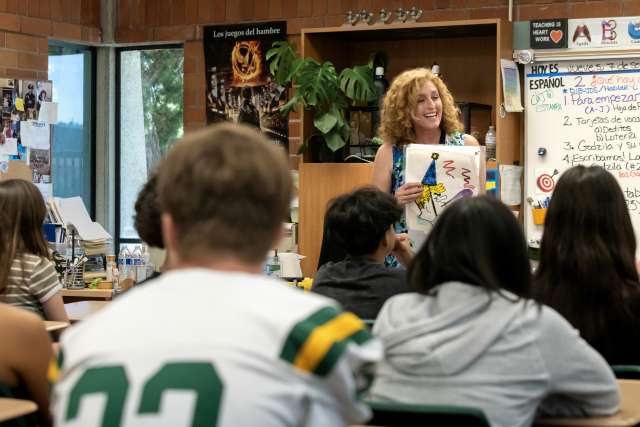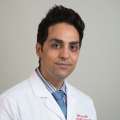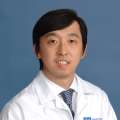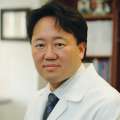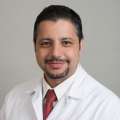Driving home with her 10-year-old daughter one evening in June of 2020, Kelly Seidenkranz felt a pain in her chest. Being healthy and having almost no illnesses in her family history, Seidenkranz figured it was just heartburn.
She called her husband, who suggested she go to the emergency room — just to be safe.
After tests at the nearby Henry Mayo Newhall Hospital, a UCLA Health affiliate, the staff told Seidenkranz, now 52, that she was having a heart attack.
"I was shocked. I'm rarely sick. I didn't go to doctors. I exercise and eat healthy, and there is nothing like this in my family," Seidenkranz said.
Fortunately, James S. Lee, MD was on duty. The UCLA Health cardiologist recognized that Seidenkranz was suffering from a rare heart condition in which the layers of the entire left side formed a tear, shutting down circulation and causing the massive heart attack and cardiogenic shock.
The condition typically affects healthy women in their 40s and 50s, especially during extreme hormonal changes (pregnancy, use of oral contraceptives, postmenopausal therapy) or due to inherited conditions.
Instead of going home that night, Seidenkranz learned she needed multiple emergent heart procedures to save her life.
Ultimately, she would not go home for more than two months, and she would need heart and kidney transplants to survive.
Dr. Lee placed a coronary stent, that night, and contacted , cardiothoracic surgeon and director of UCLA’s Adult ECMO program, to place an extracorporeal membrane oxygenation (ECMO) device. The machine pumped and oxygenated the blood outside Seidenkranz's body to keep her alive for transport to Ronald Reagan UCLA Medical Center in Westwood.
A usually fatal condition
Dr. Lee says he remembers that night well, particularly the moment he looked at Seidenkranz’s EKG and coronary angiogram.
“The initial picture was something that almost every interventional cardiologist dreads," Dr. Lee said. "Right away, we suspected that she had a very rare presentation called spontaneous coronary artery dissection of the left main artery."
Dr. Lee said the underlying condition that most often leads to spontaneous coronary dissection is fibromuscular dysplasia.
"If something is going on in that area known as the left main artery it's severe, and the majority of the circulation is compromised to the entire left side of the heart," Dr. Lee said.
Most people who experience this cardiac event, he said, do not even make it to a hospital. "Most people die at home when they have this condition," Dr. Lee said. "I had never seen a case quite like this.”
Few hospitals in the community have the equipment required for the procedures used to save Seidenkranz’s life that night, Dr. Lee said, and it was the affiliation with UCLA Health that made the difference.
Multiple transplantations
Following surgery, Seidenkranz was transferred to Ronald Reagan UCLA Medical Center so she could be monitored while her blood was pumped mechanically.
Doctors tried to save her heart during the three weeks she was in the hospital, but the heart muscle had suffered too much damage. The only way to save her was a new heart. A donor match was found in about 10 days and transplanted by cardiothoracic surgeon . Doctors also had to replace her kidneys, which were damaged by the lack of blood from her failing heart.
"Of course I was hoping to keep my own heart," Seidenkranz said. "But then I really started having trouble just breathing, because of my heart, and that was terrifying. So, when they told me that my heart could not be saved, I was just so grateful that a matching donor heart and kidneys were found in time. And I knew I was in good hands."
Seidenkranz’s complex cardiac care was coordinated under the guidance of Ali Nsair, MD, director of UCLA’s .
"It is accurate to say that there are very few medical locations that would have been able to save her life from this rare condition," Dr. Nsair said. "Fortunately, we were able to open up her arteries successfully, and to put her on this heart pump device called an ECMO, to keep her alive while waiting for a new heart, because unfortunately her heart muscle was so damaged."
Seidenkranz, a Spanish teacher at Canyon High School in Canyon Country, received her kidney transplants the day after her heart replacement.
Then came the very difficult task of getting her body to work.
Finding support during recovery
"I couldn't even stand up on my own, after all that time in bed with a heart pump. Apparently, this is very common for transplant patients. But they helped me to get up and out of bed, because you have to move after these procedures. I could walk slowly and with a walker in the hospital to get my circulation going," she said.
During one walk through the hallway, Seidenkranz met another woman doing the same, after receiving a lung transplant.

"So now we think of ourselves as transplant sisters. We had our surgeries on the same day, and we think it was the same donor. We consider each other family, and now we stay in touch," Seidenkranz said. "We even found out we have the same birthday, so now we celebrate our birthday together, one way or another."
Her transplant sister was not the only new friend Seidenkranz would make during recovery. She joined a support group of heart transplant survivors that she still engages with on video conference calls.
"We will meet up on Zoom and try out recipes, cook together and even have candlelight dinners together. And that has been really cathartic, to share with others who have been through the same ordeal that is hard to really understand unless you experience it," she said. "It is really neat to meet some wonderful people, who have been through this incredible journey and survived. I've been lucky to share this journey with some amazing, beautiful people."
Enjoying the fellowship with other transplant survivors inspired Seidenkranz to participate in a Transplant Games of America competition in San Diego. She won a gold medal in tennis.
"I had never entered a tennis tournament in my life. But my family and I have always loved playing tennis, and I wanted to help support the cause of increasing awareness about transplants," Seidenkranz said.
She now feels healthy and fit – walking 3 miles a day – but it took time.
"I had great support and encouragement from a great friend who came over at the start to walk with me. And, I mean, I could only walk a few blocks at first, then maybe a quarter of a mile. And really slowly. My friend was so patient and supportive, and that really helped me to keep going, to where I worked my way up to a mile, then two, then three," Seidenkranz said.
To celebrate her full recovery, Seidenkranz and her husband traveled to Hawaii, and she went snorkeling in the ocean.
"Then I knew I was back, and things were OK," she said.
While enjoying her health and vigor, Seidenkranz said she never forgets to feel gratitude for her improbable survival.
"I can't say enough about UCLA's medical staff, from the doctors to the nurses and everybody there," she said. "I know that I would not be here today without them, and without my husband and the prayers of all my family and friends. They all helped me to make it through this."
Seidenkranz’s case has helped doctors around the world learn about the condition, and the treatment needed to save patients. Dr. Lee showed her a map of locations across the globe where her case has been studied.
"That really makes me incredibly happy, to think that these doctors from around the world might learn from my case and might be able to save just one person from this," Seidenkranz said.
Tina Daunt is the author of this article.
